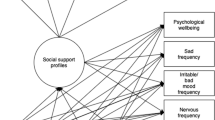Abstract
In order to examine the relationships among social network structure, types of social support, and determinants of support satisfaction, an alternative method was used to score the Social Support Questionnaire (SSQ). Factor analysis procedures suggested that college students' (N=198) social networks consisted of four groups: nuclear family, other family, friends, and others. Satisfaction with support was positively related to the proportion of the network occupied by nuclear family and negatively related to the proportion of friends in the network. Evidence was found for the presence of both support specialists and support generalists in the networks of the college students. These results are discussed from a developmental perspective with attention to the implications for interventions.
Similar content being viewed by others
References
Billings, A. G., and Moos, R. H. (1982). Work stress and the stress buffering roles of work and family resources.J. Occupational Behav. 3: 215–232.
Broadhead, W. E., Kaplan, B. H., James, S. A., Wagner, E. H., Schoenbach, V. J., Grimson, R., Heyden, S., Tibblin, G., and Gehlbach, S. H. (1983). The epidemiologic evidence for a relationship between social support and health.Am. J. Epidemiol. 117: 521–537.
Caldwell, R. A., and Bloom, B. L. (1982). Social support: Its structure and impact on marital disruption.Am. J. Community Psychol. 10, 647–667.
Caplan, G. (1976). The family as a support system. In Caplan, G., and Killilea, M. (eds.),Support Systems and Mutual Help: Multidisciplinary Explorations, Grune & Stratton, San Francisco, pp. 19–36.
Colletta, N. D. (1981). Social support and the risk of maternal rejection by adolescent mothers.J. Psychol. 109: 191–197.
Conner, K. A., Powers, E. A., and Bultena, G. L. (1979). Social interaction and life satisfaction: An empirical assessment of late-life patterns.J. Gerontol. 34: 116–121.
Conter, K. R., Hatch, C. L., and D'Augelli, A. R. (1980). Enhancing the skills of Cub Scout den leaders: Training, generalization, and maintenance.Am. J. Community Psychol. 8: 77–85.
DiMatteo, M. R., and Hayes, R. (1981). Social support and serious illness. In Gottlieb, B. H. (ed.),Social Networks and Social Support, Sage, Beverly Hills, Calif. pp. 117–148.
Erikson, E. H. (1950).Childhood and Society, Norton and Company, New York.
Gottlieb, B. H. (1981). Preventive interventions involving social networks and social support. In Gottlieb, B. H. (ed.),Social Networks and Social Support, Sage, Beverly Hills, Calif., pp. 201–232.
Granovetter, M. (1982). The strength of weak ties: A network theory revisited. In Marsden, P. V., and Lin, N. (eds.),Social Structure and Network Analysis, Sage, Beverly Hills, Calif., pp. 105–130.
Hirsch, B. J. (1980). Natural support systems and coping with major life changes.Am. J. Community Psychol. 8: 159–172.
Kriegler, J. A. (1985). Developmental aspects of social support: A multidimensional analysis of children's social networks. Unpublished master's thesis, Michigan State University, East Lansing, Mich.
Leavy, R. L. (1983). Social support and psychological disorder: A review.J. Community Psychol. 11: 3–21.
Lin, N., Dean, A., and Ensel, W. M. (1981). Social support scales: A methodological note.Schizophrenia Bull. 7: 73–89.
Lowenthal, M. F. and Haven, C. (1968). Interaction and adaptation: Intimacy as a critical variable.Am. Sociol. Rev. 33: 20–30.
Miller, P., and Ingham, J. G. (1976). Friends, confidants, and symptoms.Social Psychiatry. 11: 51–58.
Nair, D., and Jason, L. A. (1984). An investigation and analysis of social networks among children. Poster session presented at the Midwestern Psychological Association annual convention, Chicago, Illinois.
Pilisuk, M., and Minkler, M. (1980). Supportive networks: Life ties for the elderly.J. Soc. Issues 36: 95–116.
Sandler, I. N. (1980). Social support resources, stress, and maladjustment of poor children.Am. J. Community Psychol. 8: 41–52.
Sarason, I. G., and Sarason, B. R. (1982). Concomitants of social support: Attitudes, personality characteristics, and life experiences.J. Personal. 50: 331–344.
Sarason, I. G., Levine, H. M., Basham, R. B., and Sarason, B. R. (1983). Assessing social support: The social support questionnaire.J. Personal. Soc. Psychol. 44: 127–139.
Thoits, P. A. (1982). Conceptual, methodological, and theoretical problems in studying social support as a buffer against life stress.J. Health Soc. Behav. 23: 145–159.
Walker, K. N., MacBride, A., and Vachon, M. L. S. (1977). Social support networks and the crisis of bereavement.Soc. Sci. Med. 11: 35–41.
Weiss, R. S. (1976). Transition states and other stressful situations: Their nature and programs for their management. In Caplan, G., and Killilea, M. (eds.),Support Systems and Mutual Help: Multidisciplinary Explorations, Grune & Stratton, San Francisco (pp. 213–232).
Wiesenfeld, A. R., and Weis, H. M. (1979). Hairdressers and helping: Influencing the behavior of informal caregivers.Prof. Psychol. 7: 786–792.
Wilcox, B. L. (1981). Social support in adjusting to marital disruption: A network analysis. In Gottlieh, B. H. (ed.),Social Networks and Social Support, Sage, Beverly Hills, Calif., pp. 97–115.
Youniss, J. (1983). Social construction of adolescence by adolescents and parents. In Grotevant, H. D. and Cooper, C. R. (eds.),Adolescent Development in the Family. New Directions in Child Development (Vol. 22), Jossey-Bass, San Francisco, pp. 91–109.
Author information
Authors and Affiliations
Rights and permissions
About this article
Cite this article
Bogat, G.A., Caldwell, R.A., Rogosch, F.A. et al. Differentiating specialists and generalists within college students' social support networks. J Youth Adolescence 14, 23–35 (1985). https://doi.org/10.1007/BF02088644
Received:
Accepted:
Issue Date:
DOI: https://doi.org/10.1007/BF02088644




